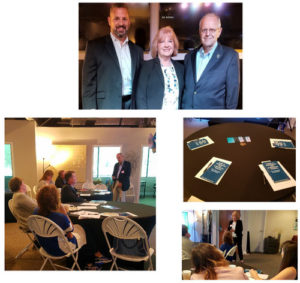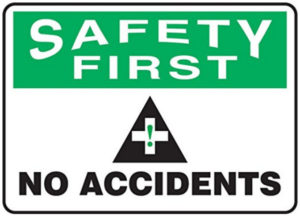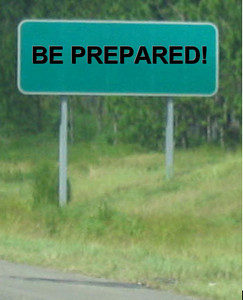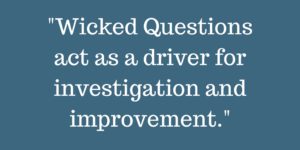Do your coworkers “care less” about your well-being? What about you, for them?
Almost every day, as I read my LinkedIn posts, there are pictures and stories about people doing really risky things.
Here are some recent examples:
- Several guys were working under a car that was lifted up by a fork truck and had no bracing.
- Many people were seen working at heights without tying off, or being otherwise secured.
- People were climbing ladders that were sitting on other ladders, or fork trucks or on buckets. People put ladders on just about anything.
- People were riding fork truck lifts to get to higher floors or to do other work of some sort.
- A fork truck driver lifted an unsecured load, which tipped over onto an improperly stored propane storage tank that was sitting right next to the load and broke off the valves.
Every day there are examples of people being really creative in solving a problem and being really stupid in how they are doing it. Where are their coworkers, their supervisors, their managers? Does anyone care?
These are the obvious safety problems. What about the less obvious problems like asbestos dust, silica dust, excessive noise, fatigue, and heat stress? WorkSafe in New Zealand estimates that many more people are injured and die from these sorts of problems than from the acute injuries like falling and tripping.
Caring about each other – so no one gets hurt – should be second-nature to us! (After all, do we not continually protect our kids from getting hurt, to do things right?)
We can only overcome these challenges by everyone taking the responsibility to look out for each other and care enough about what is going on to speak up. Then we can take the initiative to fixing things together before an injury, illness or mechanical problem takes place. Most people are doing things safely and well, but there are a few people who need help. Let’s all pull together so we can all be winners.
Raising awareness and keeping alert is something that everyone can do. Take responsibility to talk together, listen and learn, think about possibilities, and give each other a helping hand. Do this because you care.

Here are some questions that you can consider together:
- At the start of the workday, ask each other what the two most serious hazards are that we will face today in our work and what are we going to do to control those hazards?
- At the end of the shift, talk about the day and how you did in controlling the hazards, as well as discussing new hazards that came up.
- Are we prepared for the day’s work in having the right frame of mind, the right equipment and the correct PPE?
- Is everyone ready and prepared for the work?
- Is anyone troubled and distracted?
As our businesses get busier, time pressures get more intense and the push to get the job done more quickly builds up. Having short discussions about questions like these feels like it is getting in the way of getting the job done.
However, the quickest and most effective way to get a job done is to do it right the first time.
- If we haven’t got the right equipment for the job, then we will have to stop to go get it.
- If people are not ready for the day’s work, then when will they be ready?
- If the quality of our work is poor, then delays come in waiting to fix things.
- If we do not have the right PPE on hand, we will have to stop the job to get it of just take our chances.
- If we are cutting corners and haven’t thought about the hazards and someone gets hurt, everything stops and things get ugly.
Caring about yourself, about each other, and the quality of your work is something that everyone can do, if you want to.
Please step forward to make you workplaces great in every way.
 The rapid growth of active shooter incidents was one of the main areas of concern. The FBI and other experts gave talks about this, with their main focus on the active shooter incident itself. Most active shooter situations are conducted by men. Most of these occur in places of business. There is no typical profile for these people who come from all walks of life.
The rapid growth of active shooter incidents was one of the main areas of concern. The FBI and other experts gave talks about this, with their main focus on the active shooter incident itself. Most active shooter situations are conducted by men. Most of these occur in places of business. There is no typical profile for these people who come from all walks of life.

 The more people who are involved in thinking about, looking at and helping each other, the more likely that the organization’s safety performance will be outstanding. A key to having the people come together as partners in helping each other begins with respect. I think that most of us want to be treated respectfully and feel valued by each other; I know that I do. We all have jobs to do and our work quality and productivity need to be as good as we can do. We each need to be held to high standards and keep learning and growing in our knowledge and understanding. We can achieve this while treating each other respectfully, honestly sharing our knowledge and insights, asking for help when we need it, and giving a helping hand.
The more people who are involved in thinking about, looking at and helping each other, the more likely that the organization’s safety performance will be outstanding. A key to having the people come together as partners in helping each other begins with respect. I think that most of us want to be treated respectfully and feel valued by each other; I know that I do. We all have jobs to do and our work quality and productivity need to be as good as we can do. We each need to be held to high standards and keep learning and growing in our knowledge and understanding. We can achieve this while treating each other respectfully, honestly sharing our knowledge and insights, asking for help when we need it, and giving a helping hand. We help to knock down the walls that have grown up between people and groups so that the arguments and fighting stop and they learn to value and help each other. We help to drill holes in the silos of production, HR, maintenance, and finance so that people can talk to each other to get the information they need to do their jobs. We help to remove the barriers that are restricting the up and down flow of critical information, improving its accuracy, so the organization can function more easily. We help to remove the barriers between the people writing rules and procedures (the work-as-imagined) and those doing the front-line work (the work-as-done). We help people to see that most of the injuries and incidents are the result of patterns and processes that need improvement and shift away from a culture of blame and criticism.
We help to knock down the walls that have grown up between people and groups so that the arguments and fighting stop and they learn to value and help each other. We help to drill holes in the silos of production, HR, maintenance, and finance so that people can talk to each other to get the information they need to do their jobs. We help to remove the barriers that are restricting the up and down flow of critical information, improving its accuracy, so the organization can function more easily. We help to remove the barriers between the people writing rules and procedures (the work-as-imagined) and those doing the front-line work (the work-as-done). We help people to see that most of the injuries and incidents are the result of patterns and processes that need improvement and shift away from a culture of blame and criticism. Changes are coming fast and furious. President Trump is moving ahead on deregulations and removing barriers to improve our businesses, so we’ll probably see a lot of changes show up in our workplaces. Some will be positive and others will not. It is our responsibility to work together and make all these changes as good as possible.
Changes are coming fast and furious. President Trump is moving ahead on deregulations and removing barriers to improve our businesses, so we’ll probably see a lot of changes show up in our workplaces. Some will be positive and others will not. It is our responsibility to work together and make all these changes as good as possible. Almost every day I see people post on LinkedIn, engaging in awful safety practices. Some are so ridiculous that they could be funny – except that people are getting hurt. Some workers seem quite content to endanger their lives and co-workers seem to be so unaware of the risks around them – that it is unbelievable!
Almost every day I see people post on LinkedIn, engaging in awful safety practices. Some are so ridiculous that they could be funny – except that people are getting hurt. Some workers seem quite content to endanger their lives and co-workers seem to be so unaware of the risks around them – that it is unbelievable! A recent Gallup study conducted over several years, covering about 150 countries, revealed that only about 15% of the people were actively involved in their work and that another 15% were actively opposing their managers and supervisors. The other 70% must be just doing as little as possible and not helping or looking out for each other. We are better in the USA, but not by much.
A recent Gallup study conducted over several years, covering about 150 countries, revealed that only about 15% of the people were actively involved in their work and that another 15% were actively opposing their managers and supervisors. The other 70% must be just doing as little as possible and not helping or looking out for each other. We are better in the USA, but not by much. One of the most effective things that I did in stressful and changing times like these was to follow these three rules:
One of the most effective things that I did in stressful and changing times like these was to follow these three rules: There are three important things that everyone needs to do to help to keep the safety performance and productivity high:
There are three important things that everyone needs to do to help to keep the safety performance and productivity high: In your tool box meetings or shift start meetings, consider expanding your thinking to imagine how someone could get killed in work planned for the day. This is beyond what most groups do, but is an excellent way to prevent an unlikely tragedy. Talk together about how a fatality could happen. Even the most unlikely scenario will happen one day. Talk about what is in place that will prevent the fatality if the event should happen. Then ask yourselves if these preventative measures are good enough to really protect you. If not, then consider what you need to do so that you will be protected from being killed if the unlikely event should happen.
In your tool box meetings or shift start meetings, consider expanding your thinking to imagine how someone could get killed in work planned for the day. This is beyond what most groups do, but is an excellent way to prevent an unlikely tragedy. Talk together about how a fatality could happen. Even the most unlikely scenario will happen one day. Talk about what is in place that will prevent the fatality if the event should happen. Then ask yourselves if these preventative measures are good enough to really protect you. If not, then consider what you need to do so that you will be protected from being killed if the unlikely event should happen. A wicked question is one where it is so complex that there is no final answer. We work to the best solution we can, which works for some period of time, then we have to revisit it again as conditions change. (The wicked question keeps repeating, sometimes reminding us of a bad penny – that keeps showing up at inopportune times!)
A wicked question is one where it is so complex that there is no final answer. We work to the best solution we can, which works for some period of time, then we have to revisit it again as conditions change. (The wicked question keeps repeating, sometimes reminding us of a bad penny – that keeps showing up at inopportune times!) We need to approach this from the whole systems perspective since everything is connected to everything else. Experience shows that if we try to just fix one part of the system or another, we will wind up making other parts worse.
We need to approach this from the whole systems perspective since everything is connected to everything else. Experience shows that if we try to just fix one part of the system or another, we will wind up making other parts worse.
 Recognize Einstein’s Words of Wisdom: “Insanity is doing the same thing over and over again, but expecting different results.“
Recognize Einstein’s Words of Wisdom: “Insanity is doing the same thing over and over again, but expecting different results.“ OSHA recently reported that there were about 5,190 workplace fatalities in 2017. This is almost a 7% increase over 2016. I expect that this partly reflects the higher levels of business activity and more people who are working. Still, every single number reflects a personal tragedy – the death of a worker.
OSHA recently reported that there were about 5,190 workplace fatalities in 2017. This is almost a 7% increase over 2016. I expect that this partly reflects the higher levels of business activity and more people who are working. Still, every single number reflects a personal tragedy – the death of a worker. In 2001, Jim C. Collins wrote the best-selling management book, Good to Great: Why Some Companies Make the Leap…and Others Don’t. It described how companies transition from being good companies to great companies and how most companies fail to make that transition. The author found that focused leadership, clear expectations and alignment, and staying true to their field of major competence was key. There were other factors about greatness that showed up too – like Leaders being humble, and high employee engagement – employees being in tune with the company’s purpose, mission, endeavors, goals – not just the business side of things, but on the people side of the enterprise. Line organizations integrated information; people were involved, included and respected – because getting the right people in the right places was deemed as essential too. Entire organizations were communicating, collaborative, and cooperating.
In 2001, Jim C. Collins wrote the best-selling management book, Good to Great: Why Some Companies Make the Leap…and Others Don’t. It described how companies transition from being good companies to great companies and how most companies fail to make that transition. The author found that focused leadership, clear expectations and alignment, and staying true to their field of major competence was key. There were other factors about greatness that showed up too – like Leaders being humble, and high employee engagement – employees being in tune with the company’s purpose, mission, endeavors, goals – not just the business side of things, but on the people side of the enterprise. Line organizations integrated information; people were involved, included and respected – because getting the right people in the right places was deemed as essential too. Entire organizations were communicating, collaborative, and cooperating.




